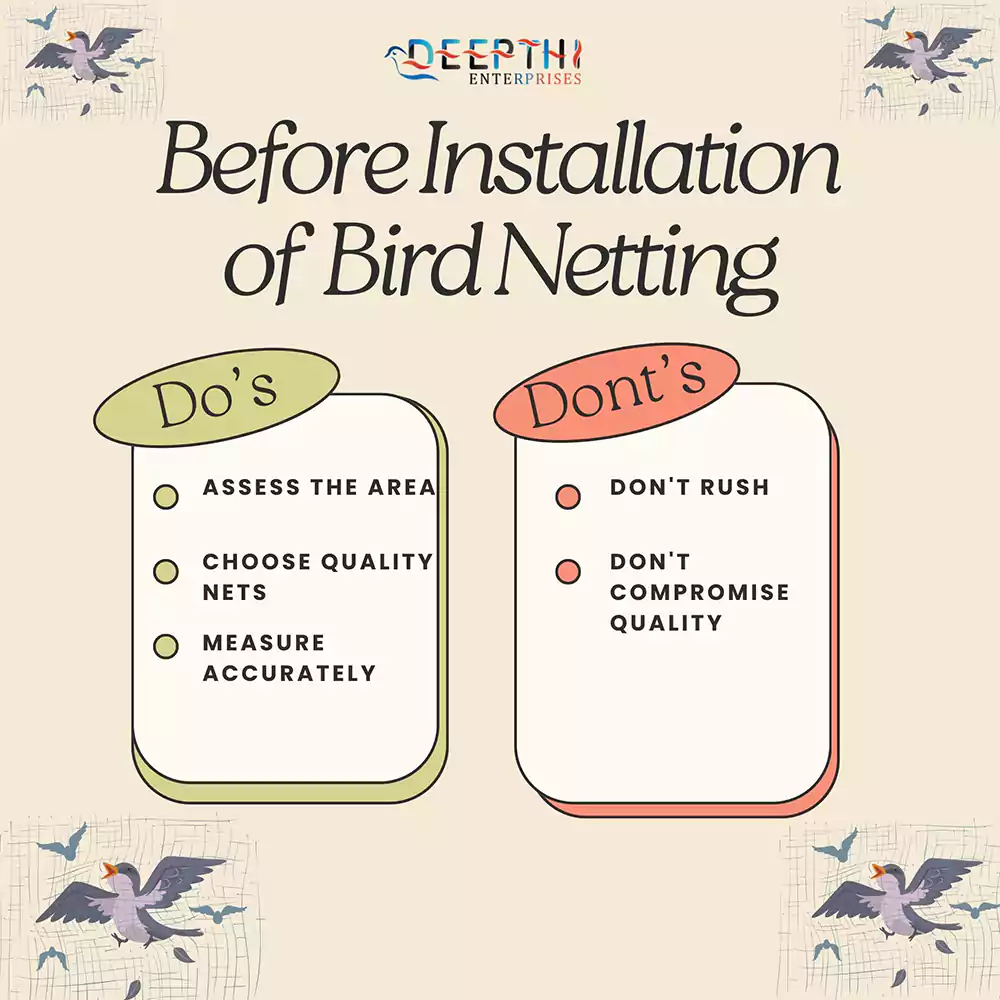Updated on Saturday, January 20, 2024
Bird Netting
Bird netting stands out as the most efficient approach for bird control, and it is entirely humane. Its purpose is to deter birds from causing harm to specific locations or structures, making it suitable for use in commercial, industrial, and residential settings. Employing Bird Netting as a pest bird control solution offers numerous advantages.

Before Installation:
Do's:
Assess the Area: Carefully inspect your property to identify areas where bird nets are needed.
Choose Quality Nets: Invest in high-quality bird nets made of durable materials like HDPE or nylon.
Measure Accurately: Measure the installation area accurately to ensure you purchase the right-sized
net.
Don'ts:
Don't Rush: Avoid rushing into the installation without a clear plan and measurements.
Don't Compromise Quality: Avoid purchasing cheap or low-quality nets; they may not provide
effective bird control.
While Installing:
Do's:
Clean the Area: Ensure the installation area is clean, removing debris and any bird nests if present.
Use Proper Tools: Use appropriate tools and safety gear, such as gloves and safety glasses.
Materials:
Bird Nets: High-quality bird netting made of materials like HDPE or nylon.
Netting Accessories: Accessories such as corner connectors, cable ties, and hooks for securing the
netting.
Anchor Points: Anchors like eye bolts, wall plugs, and screws to attach the net to surfaces.
Safety Gear: Personal protective equipment (PPE) including gloves, safety glasses, and a helmet.
Securely Attach: Make sure the net is securely attached to all anchor points to prevent gaps.
Tools:
Measuring Tape: For accurate measurements of the installation area.
Ladder or Scaffolding: Depending on the height of the installation area.
Drill and Bits: For making holes in surfaces to attach anchor points.
Cable Tie Gun: To secure the netting in place with cable ties.
Scissors or Utility Knife: For cutting and trimming the netting as needed.
Screwdriver: To secure anchor points.
Hammer: If using nails or staples for securing the net.
Level: To ensure the net is installed evenly.
Safety Harness: For working at heights, especially for larger installations.
Bucket or Container: To carry tools and accessories.
First Aid Kit: In case of minor injuries during installation.
Net Repair Kit: In case you need to patch or repair the net.
Cleaning Supplies: To clean the installation area before attaching the net.
Don'ts:
Don't Skip Safety Gear: Never install nets without wearing appropriate safety gear to protect
yourself.
Don't Rush: Take your time during installation to avoid mistakes and gaps in the netting.
After Installation:
Do's:
Regular Inspections: Periodically inspect the net for damage or wear and tear.
Maintenance: If you notice damage, promptly repair or replace the damaged sections.
Don'ts:
Don't Neglect Maintenance: Avoid neglecting regular net inspections and maintenance.
Don't Harm Birds: Always opt for humane bird control methods; don't harm or trap birds.
Bird Net Thickness and Its Types:
Bird nets come in various thicknesses, often measured in millimeters (mm) or inches (in). The choice
of net thickness depends on the specific application and the level of protection required.
Here are common bird net thickness types:
Standard Bird Netting (0.7 mm - 1.0 mm): This is the most commonly used bird netting thickness and
is suitable for general bird control in residential and commercial settings. It is lightweight, easy to
install, and provides effective protection against birds.
Heavy-Duty Bird Netting (1.0 mm - 2.0 mm): Heavy-duty bird netting is thicker and more robust than
standard netting. It is ideal for applications where greater durability and strength are required, such
as in industrial or agricultural settings.
Extra-Heavy-Duty Bird Netting (2.0 mm and above): This type of netting is the thickest and strongest.
It is used in areas where extreme durability and resistance to heavy bird pressure are essential, such
as at airports or in large agricultural operations.
Knotted Bird Netting: Knotted bird netting is typically available in various thicknesses, and the knots
add extra strength. It is often used in agricultural and industrial applications.
By following these do's and don'ts before, during, and after installation will help ensure a successful
and humane bird net installation at home.



